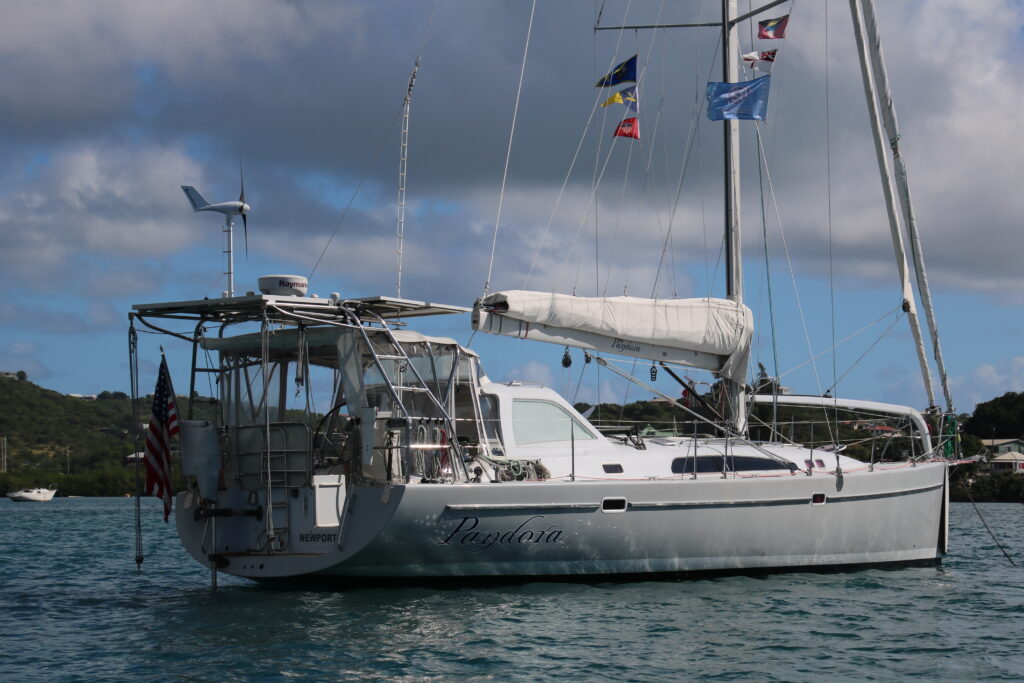
By Bob Osborn
After years of thinking about upgrading the house bank to lithium on Pandora, our 2007 Aerodyne 47 sloop, we decided to move forward and ordered four 210AH batteries from Blue Heron Batteries. I decided to go with that brand since I know the principal Hank from my years on the board of The Salty Dawg Sailing Association and trusted him to provide a quality product and support, which was particularly important to me given the horror stories I had heard about fires and other issues associated with lithium batteries
I wrote about the installation considerations in BWS Fall 2022. Last fall, I ran Pandora to Antigua as part of the Salty Dawg Rally to the Caribbean. The 1,500-mile run proved to be a great shakedown giving me a feel for the performance of the new bank. BWS publisher George Day was with me for the run and also saw, first hand, how the upgraded electrical system performed.
In order to be sure that I could get the best performance from the new batteries, I upgraded a number of my older solar panels, bringing my capacity to 900 watts and added a wind generator.
This year marks the beginning of our second decade as snowbirds and I have plenty of experience to draw on when making comparisons. Pandora does not have a house generator and while her old AGM bank and solar panels were adequate when we were anchored, on passage I generally had to run the engine at least once every 24 hours to keep the house bank properly charged as the load from instruments and autopilot were more than the panels and AGM batteries could support. While I expected the charging rate of lithium to be better, I was very pleased to find that during the two-thirds of the run to Antigua that was under sail, I no longer needed to run the engine at all to keep the bank fully charged, and the batteries never dropped below 84% of a full charge.
Pandora has substantial energy requirements while on passage, drawing about 8 amps with the autopilot and instruments operating round the clock. The large freezer and refrigerator add to that load consuming more than 75 amp-hours a day. The new solar panels and wind generator easily replenish the batteries every day with the wind generator able to supply the bulk of the power needs of the instruments and autopilot when sailing in 20 knots of apparent on a close reach. This performance was beyond what I had expected, and I was impressed that the batteries were able to absorb all the power available with no apparent resistance, regardless of the state of charge. The theoretical power curve for the wind generator shows 8 amps of output at 20 knots of wind, and that’s exactly what the batteries took, with no discernable charge resistance, even when at 95% charge.
We have no house generator and our 55hp engine is fitted with a power takeoff driving a large 280-amp alternator. The new bank easily accepts a full 200 amps right up until the batteries are fully charged, a tremendous increase in charging efficiency over my prior AGM bank where input would slow to a trickle the closer the bank got to full charge. In planning the new bank, I had been very focused on the total usable amp-hours and yet that didn’t come into play as the batteries stayed at near full charge between the solar and wind. I was even able to run my Spectra water-maker when sailing, something that I have never been able to do in the past.
Years ago, our need for power was minimal, primarily focused on a few lights and perhaps mechanical refrigeration. Nowadays, boats are more power hungry with a whole fleet of devices, computers, cell phones, rechargeable lights, autopilot, navigation instruments, microwave, TV, water maker that grows every year.
Staying ahead of this increasing load is so much easier with fast charging lithium batteries. I had considered adding a dedicated house generator and now, with the exception of air conditioning, I no longer feel that is needed. In fact, I have wired my inverter to heat hot water and even plan to configure our washing machine to run off the inverter.
In addition to upgraded solar (the old panels had lost more than 50% of their power output), I chose the Marine Kinetix wind generator since a few of my friends have that unit and are happy with the power output and near silent operation.

After struggling with power issues for so long, it is remarkable to see how much better things are now. The lithium bank has made more of a difference than I expected as the batteries suck up power at a much faster rate. Even if the batteries are nearly full, they continue to accept all available power up to 100%, so different from lead acid batteries in which the acceptance rate slows to a trickle the closer the batteries get to full charge.
While our energy needs continue to grow, we now have excess power storage capacity, multiples beyond my old AGM bank, and now I can even keep everything fully charged on passage without running the engine except when there is little wind.
The newest generation of lithium batteries are safer than ever so now is the time to consider an upgrade as a key part of a comprehensive energy production and storage program.
For more information:
Blue Heron Batteries. https://www.blueheronbattery.com/
Marine Kinetics Wind Generator. https://store.marinebeam.com/marinekinetix-mk4-marine-wind-generator/
Salty Dawg Sailing Association: www.saltydawgsailing.org















